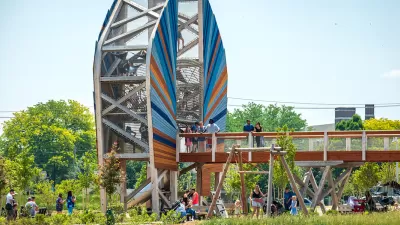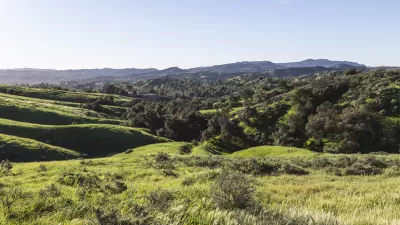Some argue that if something is not directly contributing to our public coffers, why protect it? Perhaps it’s worth broadening our understanding of the services – and tax implications – provided by parks.
A recent Smithsonian retrospective featured records from the 1970s Environmental Protection Agency. One of the more personally interesting ones is from 1972: A woman holding a placard is standing before a strip mall of shops protesting the protection of an ecologically sensitive area. Her placard reads, “We pay taxes; parks don’t”.
According to EPA records, the Ocean Beach businesswoman raising the placard led a fight to reopen a beach that had been closed to auto traffic. The state government had banned cars from a stretch of beach during the summer months to protect clam beds. The woman demonstrated against this by joining with 200 other motorists to drive the two miles over the prohibited section of the beach.
Her statement, of course, is correct. In the most literal sense, parks don’t have agency to pay taxes. Birds don’t pay taxes either, nor do trees. How far should we extend her argument? Her point, however, is understood. If something is not directly contributing to our public coffers – and affecting our liberty – why protect it?
It has been argued that parks make cities less affordable as they limit developable land and therefore disrupt the “law” of supply and demand housing stock: less land supply, less houses = increased value in existing housing stock. This is an awfully narrow interpretation of park space and perhaps it’s worth broadening our understanding of the services – and tax implications – provided by parks.
Parks provide recreation and tourism value in terms of tax revenue and commercial activities. They provide a space for the consumption of goods and services such as picnic areas or concert venues. Property values of adjacent residential and commercial areas can be measured against properties in the same neighbourhood that don’t border a park: a (well cared for) park nearby increases property values.
Parks also provide “ecosystem services” that can be quantified to measure environmental benefits. For example they also provide flood control and mitigation through permeable surfaces allowing the absorption of water. They regulate air quality and temperature by reducing “heat islands” associated with areas covered by asphalt and concrete which tend to create a dome of heat above their surfaces impacting not only human comfort but plant and wildlife tolerance.
A 2004 report by Ducks Unlimited & Nature Conservancy Canada [PDF] showed that protected wetlands regulate water supply and treatment, as well as are a component in food production by providing plants for pollinators.
The mitigation and regulatory services provided by parks has direct financial benefits. Engineered infrastructure costs can be lessened – from concrete storm water systems to the necessity of air conditioning units. A 2011 report by Alberta Environment [PDF] focusing on the southwest edge of Calgary revealed the cost of replacing the storm water services provided by the area’s wetlands with built infrastructure would be $338 million.
Indirect benefits of parks should also to be realized. A 2005 report in the American Journal of Medicine [PDF] indicated that people with ready access to a park were 50% more likely to adhere to a regular walking regime, increasing their mental and physical well-being and thus decreasing health care costs.
Research shows that common spaces with vegetation receive more use and therefore increase opportunities for social interaction among users. This has the potential to advance community cohesion contributing to psychological wellness, again revealing the tacit relationship between parks and health services.
A 2013 article in the American Journal of Preventive Medicine [PDF] indicated that when there is a major change to our natural environment, evidence points to an increase in mortality related to heart and lung illness. The study showed that the widespread removal of an area’s tree canopy led to a psychological impact on residents leading to negative health impacts.
The services provided by parks, from regulatory to cultural, are gaining traction in economic evaluations; parks are being economically quantified to justify their protection. What are the benefits to this approach? What are the drawbacks? My next article will explore this topic.

Alabama: Trump Terminates Settlements for Black Communities Harmed By Raw Sewage
Trump deemed the landmark civil rights agreement “illegal DEI and environmental justice policy.”

Planetizen Federal Action Tracker
A weekly monitor of how Trump’s orders and actions are impacting planners and planning in America.

The 120 Year Old Tiny Home Villages That Sheltered San Francisco’s Earthquake Refugees
More than a century ago, San Francisco mobilized to house thousands of residents displaced by the 1906 earthquake. Could their strategy offer a model for the present?

In Both Crashes and Crime, Public Transportation is Far Safer than Driving
Contrary to popular assumptions, public transportation has far lower crash and crime rates than automobile travel. For safer communities, improve and encourage transit travel.

Report: Zoning Reforms Should Complement Nashville’s Ambitious Transit Plan
Without reform, restrictive zoning codes will limit the impact of the city’s planned transit expansion and could exclude some of the residents who depend on transit the most.

Judge Orders Release of Frozen IRA, IIJA Funding
The decision is a victory for environmental groups who charged that freezing funds for critical infrastructure and disaster response programs caused “real and irreparable harm” to communities.
Urban Design for Planners 1: Software Tools
This six-course series explores essential urban design concepts using open source software and equips planners with the tools they need to participate fully in the urban design process.
Planning for Universal Design
Learn the tools for implementing Universal Design in planning regulations.
Clanton & Associates, Inc.
Jessamine County Fiscal Court
Institute for Housing and Urban Development Studies (IHS)
City of Grandview
Harvard GSD Executive Education
Toledo-Lucas County Plan Commissions
Salt Lake City
NYU Wagner Graduate School of Public Service






























